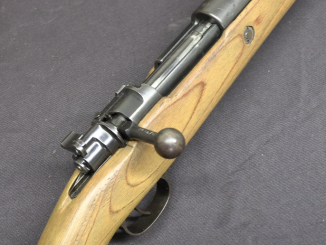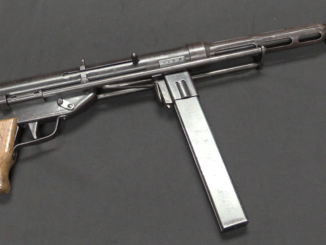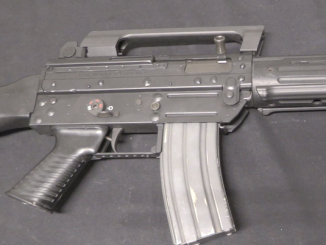The ZK-391 is one in a series of Czech developmental semiautomatic rifles designed by Josef Koucký. It was developed initially in 1939 (hence the “39” in the designation), and was tested by the Italian military in 1943. It was ultimately not put into production, but nonetheless is an interesting detail of rifle development – a Czech design made under German occupation (note the Waffenwerke Brunn marking) for Italian trials (note the Italian safety markings).
Mechanically, the rifle shared many elements with the M1 Garand, including the two-lug rotating bolt, the long stroke gas piston, and the removable gas tube. It has several unique elements as well, like the trigger guard doubling as a lever to recock the hammer and the out of battery safety mechanism incorporating the receiver top cover.
Thanks to the Institute of Military Technology for allowing me to have access to this rifle so I can bring it to you!




What is it chambered for? 6.5 or 7.35 Carcano? Or 7.92×57?
Are there other muzzle devices other than the muzzle brake? Grenade launching attachment? Blank firing adapter?
I am not sure of the usefulness of the recocking trigger guard but this is an interesting trigger group. I wonder if the bolt lock feature could be developped into a selective fire gun firing semi-auto from closed bolt and full-auto from open bolt? That could be pretty neat in 6.5 with a higher capacity detachable magazine.
This rifle was at auction a few years ago, and the description says “8mm”:
https://www.cowanauctions.com/lot/wwii-czechoslovakian-zk-391-prototype-semi-auto-rifle-rare-129157
I am pretty sure it is the last one. Brno had no reason to play with Italian calibers before the war/ occupation. Where ever they exported/ offered was in 8mm Mauser.
IMHO it’s 8mm Mauser based on the length of the magazine. There really needs to be a good English book on Czech firearms development from 1920 to 1950 or so.
I would say it is 7,9×57 mm based on https://www.valka.cz/15244-Zbranari-par-excellence-Bratri-Josef-a-Frantisek-Koucti-1-dil
(this is article about Koucký brothers, in Czech – i might misunderstand something so correct me if needed)
excerpt
Josef se angažoval také ve vývoji samonabíjecích pušek s odvodem plynů z vývrtu hlavně na píst, kterých vytvořil do okupace hned několik typů – ZK 371, ZK 373, ZK 381 (puška ZK 381 Au se dokonce zkoušela v létě 1938 v Sovětském svazu). V roce 1939 pak vznikla úplně odlišná konstrukce ZK 391. Poslední prototyp už prý „měl bezvadnou funkci a přesnost a odpovídal požadavkům armády“. Od něj se Zbrojovka odrazila po válce, ale ačkoliv ho předtím zkoušel i sám slovenský ministr národní obrany a vyrobily se i vzorky pro Itálii, vývoj zřejmě nepřekročil stadium vzorků.
which I understand as:
Josef [Koucký] also worked on development of self-loading rifle gas-operated [fragment which I don’t understand]. Before occupation he created – ZK 371, ZK 373, ZK 381 (ZK 381 Au was tested in Soviet Union in summer 1938). In 1939 he created different construction – ZK 391. Last [final?] prototype have “fail-less function and precision [accuracy] and full-filled [Czechoslovak?] army requirements”. Zbrojovka [factory for which Josef worked] abandoned it after [Second World?] war, but before that it was tried by Slovak ministry of defense, as well samples for Italy were made, development did not go beyond prototypes [samples]
Thus 7,9×57 make sense as it was default Czechoslovak rifle cartridge in 1930s.
Valka cz has photos of mentioned ZK 381
http://forum.valka.cz/topic/view/141163
and description of it:
Czechoslovak Selfloading Rifle ZK 381 Model Calibre 7,92 mm Mauser –
Cuttaway
“Josef se angažoval také ve vývoji samonabíjecích pušek s odvodem plynů z vývrtu hlavně na píst, kterých vytvořil do okupace hned několik typů …’
————————–
“Josef K. was involved with development of self-loading rifles with diversion of gas from bore to piston, of which he developed before occupation several models/ types …’
Thus it appears that whatever the inscription on rifle is, it is more-less related to date of manufacture/ presentation, not necessarily of the design/ development. I feel with degree of certainty that there was no German participation in these developments. It is entirely Brno’s own.
I bough a book, fairly lavishly dressed there at around 2000; it was bilingual. But it did not go into sufficient depth to be representative. The appendix was full of commercials on Sellier-Bellot ammunition.
Thing of beauty.
“Thing of beauty.”
If you liked this one, you would probably also like other Josef Koucký designs, VHU PRAHA has nice photos of them (click to enlarge):
ZK 420-S (7,5 x 55 mm GP11) http://www.vhu.cz/exhibit/samonabijeci-puska-zk-420-s/
ZK 503/2 (7,62 x 45 mm) http://www.vhu.cz/exhibit/utocna-puska-zk-5032/
ZK 423 (7,92 x 33 mm) http://www.vhu.cz/exhibit/maly-kulomet-zk-423/
ZK 407 (Patrone 318) http://www.vhu.cz/exhibit/samonabijeci-protitankova-puska-zk-407/
ZK 383-P (9×19 mm) http://www.vhu.cz/exhibit/ceskoslovensky-vyvojovy-samopal-zk-383-p/
ZK 476 http://www.vhu.cz/exhibit/cs-samopal-zk-476/
Considering the gas cylinder and op-rod configuration, I’d have said closer to T-44/M-14 than M-1 Garand. And only about a decade before the T-44, hmmmm.
Citing https://en.wikipedia.org/wiki/Ferdinand_Mannlicher
According to WHB Smith in “Mauser, Walther and Mannlicher Firearms” the Mannlicher 1885 became the inspiration for the M1 Garand(…)
Now I am wondering if Josef Koucký was aware of that Mannlicher work?
Most likely yes; there was lots of cross-pollination. Also, couple of Czech designers started in Austria and after 1918 they moved to their native land.
The ZK 391 indeed fired the 7.92 mm as it was called in Czechoslovakia after adoption of the German 7.9 mm cartridge in the wake of WW1.
Daweo, keep in mind that Czechoslovakia was part of Austria-Hungary until its indepencence in 1918. For example, Czech Karel Krnka (as “Kaisertreu”!!!) published a book in which he was very critical about the designs of his competitor (Krnka worked for Roth) Mannlicher.
Speaking of designers: Paul Mauser was not at all involved in developing the German 7.9 mm cartridge. Its SAAMI name “8 mm Mauser” is a little misleading in this respect.
“Karel Krnka”
Photos of one of his self-loading rifles can be seen here:
http://www.vhu.cz/exhibit/pokusna-samonabijeci-puska-krnka-hirtenberg/
If I understand correctly it is from 1908 year, it use cartridge 7 mm Krnka pokusný (I have no clue what this is)
Pokus = experiment; pokusny = experimental (opytnyi).
Am I all alone in believing this could be a worthy production rifle. It would be more expensive to produce than the Garand, but it has some seductive features to it (anyone who ever got a case of “M1 Thumb” would agree with one of those features).
You’re not alone. Using the trigger as the bolt release makes loading a semiautomatic rifle simple and much safer for your fingers if you load with clips. Even with detachable magazines, the fewer controls that can go wrong, the better.
M1 thumb is the result of a worn out rifle or some one who is careless about reloading.
The op rod can be moved to the rear with the heel of the right hand so if your hand is in the right position the tang on the op rod will push your hand out of the way. The zk 391 has the bolt handle on the left side, an awkward place. I would prefer the right side with the heel of my right hand on the bolt handle. Really don’t like to find fault with a beautifully made rifle but it is way to nice fit and finish for a combat rifle.
Then you have never seen trainees learning to close the bolt on an M1 or and M14 while learning inspection arms…
It appears this gun was not fired even once. Finishes and machining are splendid (material is probably electro-steel by Poldi Kladno, a company who was also supplying steel for Carcano rifles). I believe we have seen one Koucky’ rifle already; it was along similar lines.
My impression is that this is intended as a sporting rifle – too pretty to pass it on grunts. But by same token the semi-auto Armaguerra was also piece of art. I can see on this particular rifle reflection of ‘constructivist’ civil construction style of 1930s. Art is art and it shows.
The designers had good taste, you must admit. Not like the US Army Ordnance board of 1914 or earlier, especially if we must mention their hare-brained idea of the rod bayonet on the original M1903 rifle, which Theodore Roosevelt bent in half with his bare hands (the bayonet, not the rifle, mind you). Also worthy of note is that German arms procurement had to deal with ridiculous logistics problems borne of political meddling and failure to standardize basic equipment sets on a few levels (to the point where truck loads of rifles came from three or four different countries of origin, the only common feature being that they all fired 8×57 IS). Did I mess up?
We do not really know for sure what was going on in German supply planning systems before and at start-up of war (let’s keep on mind – Germans are known to be meticulous folks). My suspicion is that we are liable to repeated clichés, which may be true, partly true or not true at all.
Fact of the matter is that German leadership tried with all their wits to avoid full blown war on Czechoslovakia. For this very reason they had Western powers to give up on their alliance obligations during Munich conference by end of summer 1938. Czech industry was way to precious to them to destroy it.
At my last time to Europe I visited aircraft museum in Kbely near Prague. Part of exhibits is dedicated to aircraft armaments and specifically to those made by factories of Protectorate. I was amazed with visible quality of production.
“taste(…)Not like the US Army Ordnance board of 1914 or earlier, especially if we must mention their hare-brained idea of the rod bayonet on the original M1903 rifle”
Function and form are two different things. It is great to have both (pretty and useful) but if this is not possible it is better to use function before form approach (ugly and useful) than reverse (pretty and useless)
The cleaning rod bayonet was intended to reduce the weight of the infantryman’s load.
So he could be either less fatigued, or carry a greater number of cartridges.
The cartridges were already over weight, and in both 03 and 06 form were outclassed ballistically beyond 100 yards by the already in service 8mm lebel balle d and beyond a couple of hundred yards by the later .303 mk7. (See hatcher’s notebook), plus they kicked too hard and overheated the barrel…
Apart from it’s length (similar to the smle )
The entire 03 project appears to have been a triumph of politics over practicality.
The rod bayonet as a concession to already over loaded infantrymen was of course famously vetoed by Roosevelt the elder.
Weight reduction? What a laugh. Perhaps the guys in Ordnance should have tried lugging around the stuff for 2 weeks on end. How about creating a better haversack that WON’T require 20 minutes to load up? Or maybe some long distance marching practices need to be changed? Has nobody heard of “temporary supply deposits” used to lighten soldier’s pack loads? Apparently, Ordnance didn’t care. The rod bayonet being a “load reduction” is an insult to modern warfare, as though the designers believed that enemy soldiers would stand perfectly still to let you kill them with knitting needles.
Partly related to subject; just read it yesterday when inquiring about progress in Hungarian military (Magyar Honvedseg).
They apparently purchased rights to manufacture CZ806 (Bren 2) assault rifles and CZ P07 pistols. These are intended to replace all existing models in common Hungarian service. If this is true, it would equip three out of four (Poland has its own) Visegrad 4 countries with identical small arms, save for medium and heavy (large caliber) machineguns.
The ZK-391 rifle was also presented for trials to Spanish Army in late 1941. As I have said in other threads the Spanish Army was interested in acquiring Zbrojovka Brno (then Wafferwerke Brün under German control) weapons, specially its excellent machineguns, but Wafferwerke Brün also offered the ZK-391 7.92mm rifle, ZK-383 9 mm SMG and a 50 mm grenade launchers.
Spanish Army finally ordered 250 ZB-60 15 mm HMG, 1.000 ZB-53/Vz.37 MMG and 5.000 ZB-26 LMG (though only 100 were delivered).
Nicely built and finished like all Czech firearms. Way to complicated for an actual combat rifle. The Garand was a great example of how to build a rifle quickly and with reasonable accuracy. I wonder about reliability of the ZK 391 with all the fine machine work and tolerances. More like a semi auto hunting rifle for the landed gentry.
Some of the early stuff I’ve got on the garand (it may even be in the patent) covers using the trigger guard to re cock the hammer.
For Italian use in 1943, would have been for the RSI (Italian Socialist Republic), set up in northern Italy after the Kingdom of Italy switched to the Allies.
Btw, it’s pronounced “ArmagWera”.